How to Know if Your Takeout Container is Microwave-Safe?
Elevate Your Food Packaging with Ecopax
We believe that our products reflect what we do, our customers reflect who we are, and their success is ours.
Contact Sales Learn MoreHave you ever wondered what you can put into the microwave when you try to reheat the leftovers from a night out? Or have you googled the questions "can plastic go in microwave?", "is 5 pp plastic microwave safe?", or " Is styrofoam safe for reheating?"
It can be extremely confusing when determining which single-use containers are microwaveable. Especially when it comes down to plastic takeout containers, because some experts say NEVER put it in the microwave. It can cause a mess because of the melting plastic, or it will leach harmful chemicals when heating.
However, if you look at the bottom of the to-go containers, some say "microwave-safe." Others might have a small image that looks like a microwave.
So, who should we believe?
Here's a guide to everything you need to know when reheating your takeout boxes. It includes microwave safe symbols and materials.
What does Microwave-Safe Containers Even Mean?
A product that has a microwave safe plastic symbol simply means it can withstand the heat without deforming. This requires the product to tolerate at least 250 degrees Fahrenheit.

There's no single universal symbol across the board. But the most commonly recognized symbol for microwave safety is three wavy lines. Sometimes, manufacturers will go the extra mile to put a little microwave icon along with the wavy lines. Or they will just put "microwave safe" text on the containers.
However, there's no federal regulations over which plastics are safe when microwaving food. Therefore, the "microwave-safe" icon has nothing to do with the toxins, like Bisphenol A (BPA), leaching when heating. It is up to the manufacturers to decide and label their products.
Then How Do We Determine Which Plastics are Safe to Use?
Food delivery or takeout boxes made with #5 plastic, are generally safe for reheating. #5 plastic is also known as polypropylene (PP). The polypropylene food containers can withstand high temperatures up to 250 degrees before distortion.
Most importantly, it is BPA free plastic. So, there's no need to worry about the possible health effects that may come from the leaching of these toxic chemicals.
Our PP containers lineups and Mineral-Filled polypropylene (MFPP) hinged containers lineups are both BPA free containers for food.
8" x 8" x 3", 3-compartment, black base, clear lid, vented, PP, 150 units combo pack
The Pebble 3-compartment 2- piece container combo pack, measuring 8" x 8" x 3", designed for versatility and convenience in food service. This to-go containers features a durable Mineral-Filled Polypropylene (MFPP) tray and a high quality polypropylene (PP) clear vented top, ensuring presentability. This MFPP container is microwave-safe*, making it suitable for both hot and cold foods. It is perfect for serving a main dish with sides. The to-go containers are an excellent choice for daily meals or restaurants, food trucks, to-go orders, special events, and other types of food service environment. Available in 150 units combo pack (150 trays and 150 lids).
*Microwave-safe for reheating only; limit use to under 2 minutes to avoid container degradation or safety risk.
8" x 8" x 3", 1-compartment, black base, clear lid, vented, PP, 150 units combo pack
The Pebble 1-compartment 2- piece container combo pack, measuring 8" x 8" x 3", designed for versatility and convenience in food service. This to-go containers features a durable Mineral-Filled Polypropylene (MFPP) tray and a high quality polypropylene (PP) clear vented top, ensuring presentability. This MFPP container is microwave-safe*, making it suitable for both hot and cold foods. Ideal for restaurants, catering services, and takeout operations as take away containers for diverse menu options. Available in 150 units combo pack (150 trays and 150 lids).
*Microwave-safe for reheating only; limit use to under 2 minutes to avoid container degradation or safety risk.
9" x 9" x 3", 3-compartment, black tray, PP, 300 case pack.
The Pebble 3-compartment 2- piece container, measuring 9" x 9" x 3", designed for versatility and convenience in food service. This to-go containers features a durable Mineral-Filled Polypropylene (MFPP) tray and a high quality polypropylene (PP) clear vented top, ensuring presentability. This MFPP container is microwave-safe*, making it suitable for both hot and cold foods. It is perfect for serving a main dish with sides. The to-go containers are an excellent choice for daily meals or restaurants, food trucks, to-go orders, special events, and other types of food service environment. Available in 300 units.
*Microwave-safe for reheating only; limit use to under 2 minutes to avoid container degradation or safety risk.
9" x 9" x 3", 1-compartment, black tray, PP, 300 case pack
The Pebble 1-compartment 2- piece container, measuring 9" x 9" x 3", designed for versatility and convenience in food service. This to-go containers features a durable Mineral-Filled Polypropylene (MFPP) tray and a high quality polypropylene (PP) clear vented top, ensuring presentability. This MFPP container is microwave-safe*, making it suitable for both hot and cold foods. Ideal for restaurants, catering services, and takeout operations as take away containers for diverse menu options. Available in 300 units.
*Microwave-safe for reheating only; limit use to under 2 minutes to avoid container degradation or safety risk.
9'' x 9'' x 1.38'', translucent vented lid, PP, 300 case pack.
The clear vented lid is designed specifically for 9'' x 9'' x 3'' 1-compartment and 3-compartment tray. Made from polypropylene (PP) material, the clear lid's smart locking mechanism secures food while enhances the presentation. Available in 300 units.
*Microwave-safe for reheating only; limit use to under 2 minutes to avoid lid degradation or safety risk.
9.35" x 7.95" x 1.22", 2-compartment, black tray, PP, 2/160/320
The Pebble 2-compartment Grande 2- piece container, measuring 9.35" x 7.95" x 1.22", designed for versatility and convenience in food service. This to-go containers features a durable Mineral-Filled Polypropylene (MFPP) tray and a high quality polypropylene (PP) clear non-vented top, ensuring presentability. This MFPP container is microwave-safe*, making it suitable for saucy foods like pasta, stir-fry, and more. Ideal for restaurants, catering services, and takeout operations as take away containers for diverse menu options. Available in 320 units (2 sleeves of 160 counts).
*Microwave-safe for reheating only; limit use to under 2 minutes to avoid container degradation or safety risk.
9.35" x 7.95" x 1.48", 2-compartment, translucent lid, PP, 2/160/320
The clear non vented lid is designed specifically for 9.35" x 7.95" x 1.22" 2-compartment tray. Made from polypropylene (PP) material, the clear lid's smart locking mechanism secures food while enhances the presentation. Available in 320 units (2 sleeves of 160 counts).
*Microwave-safe for reheating only; limit use to under 2 minutes to avoid lid degradation or safety risk.
Our PP containers are all made with #5 recyclable plastic materials, and MFPP containers add minerals on top of the regular PP materials. The added materials further enhance heat resistance, making it even more suitable for microwaving.
6" x 6" x 3.25", 1 compartment, White, PP, Hinge Container, 250 count, 2/125/250, Pebble.
The Pebble 1-compartment white hinged container is designed for both practicality and presentation. Measuring 6" x 6" x 3.25", this microwave-safe container* is made from durable MFPP material and significantly reduces the environmental footprint by using up to 40% Earth minerals. The sturdy construction is perfect for holding both hot and cold foods, while the hinged lid offers secure closure to maintain freshness during transport. Available in 250 units (2 sleeves of 125 counts).
*Microwave-safe for reheating only; limit use to under 2 minutes to avoid container degradation or safety risk.
6" x 6" x 3.25", 1 compartment, Black, PP, Hinge Container, 480 count, 4/120/480, Pebble.
The Pebble 1-compartment black hinged container is designed for both practicality and presentation. Measuring 6" x 6" x 3.25", this microwave-safe container* is made from durable MFPP material and significantly reduces the environmental footprint by using up to 40% Earth minerals. The sturdy construction is perfect for holding both hot and cold foods, while the hinged lid offers secure closure to maintain freshness during transport. Available in 480 units (4 sleeves of 120 counts).
*Microwave-safe for reheating only; limit use to under 2 minutes to avoid container degradation or safety risk.
7.76" x 5.87" x 2.60", 1 compartment, Black, PP, Hinge Container, 340 count, 2/170/340, Pebble.
The Pebble 1-compartment black hinged container is designed for both practicality and presentation. Measuring 7.76" x 5.87" x 2.60", this microwave-safe container* is made from durable MFPP material and significantly reduces the environmental footprint by using up to 40% Earth minerals. The sturdy construction is perfect for holding both hot and cold foods, while the hinged lid offers secure closure to maintain freshness during transport. Available in 340 units (2 sleeves of 170 counts).
*Microwave-safe for reheating only; limit use to under 2 minutes to avoid container degradation or safety risk.
8.13" x 6.5" x 2.63", 1 compartment, Ivory, PP, Hinge Container, 300 count, 2/150/300, Pebble.
The Pebble 1-compartment white hinged container is designed for both practicality and presentation. Measuring 8.13" x 6.5" x 2.63", this microwave-safe container* is made from durable MFPP material and significantly reduces the environmental footprint by using up to 40% Earth minerals. The sturdy construction is perfect for holding both hot and cold foods, while the hinged lid offers secure closure to maintain freshness during transport. Available in 300 units (2 sleeves of 150 counts).
*Microwave-safe for reheating only; limit use to under 2 minutes to avoid container degradation or safety risk.
8.86" x 5.86" x 2.79", 1 compartment, Ivory, PP, Hinge Container, 150 count, Pebble., 1 compartment, Ivory, PP, Hinge Container, 150 count, Pebble.
The Pebble 1-compartment white hinged container is designed for both practicality and presentation. Measuring 8.86" x 5.86" x 2.79", this microwave-safe container* is made from durable MFPP material and significantly reduces the environmental footprint by using up to 40% Earth minerals. The sturdy construction is perfect for holding both hot and cold foods, while the hinged lid offers secure closure to maintain freshness during transport. Available in 150 units (1 sleeve of 150 counts).
*Microwave-safe for reheating only; limit use to under 2 minutes to avoid container degradation or safety risk.
9.25" x 6.5" x 2.25", 1 compartment, Ivory, PP, Hinge Container, 150 count, Pebble.
The Pebble 1-compartment white hinged container is designed for both practicality and presentation. Measuring 9.25" x 6.5" x 2.25", this microwave-safe container* is made from durable MFPP material and significantly reduces the environmental footprint by using up to 40% Earth minerals. The sturdy construction is perfect for holding both hot and cold foods, while the hinged lid offers secure closure to maintain freshness during transport. Available in 150 units (1 sleeve of 150 counts).
*Microwave-safe for reheating only; limit use to under 2 minutes to avoid container degradation or safety risk.
9.25" x 6.5" x 2.25", 1 compartment, Black, PP, Hinge Container, 150 count, Pebble.
The Pebble 1-compartment black hinged container is designed for both practicality and presentation. Measuring 9.25" x 6.5" x 2.25", this microwave-safe container* is made from durable MFPP material and significantly reduces the environmental footprint by using up to 40% Earth minerals. The sturdy construction is perfect for holding both hot and cold foods, while the hinged lid offers secure closure to maintain freshness during transport. Available in 150 units (1 sleeve of 150 counts).
*Microwave-safe for reheating only; limit use to under 2 minutes to avoid container degradation or safety risk.
7.88" x 8" x 2.75", 3 compartment, White, PP, Hinge Container, 150 count, Pebble.
The Pebble 3-compartment white hinged container is designed for both practicality and presentation. Measuring 7.88" x 8" x 2.75", this microwave-safe container* is made from durable MFPP material and significantly reduces the environmental footprint by using up to 40% Earth minerals. The sturdy construction is perfect for holding both hot and cold foods, while the hinged lid offers secure closure to maintain freshness during transport. Available in 150 units (1 sleeve of 150 counts).
*Microwave-safe for reheating only; limit use to under 2 minutes to avoid container degradation or safety risk.
7.88" x 8" x 2.35", 3 compartment, White, PP, Hinge Container, 150, Pebble.
The Pebble 3-compartment white hinged container is designed for both practicality and presentation. Measuring 7.88" x 8" x 2.35", this microwave-safe container* is made from durable MFPP material and significantly reduces the environmental footprint by using up to 40% Earth minerals. The sturdy construction is perfect for holding both hot and cold foods, while the hinged lid offers secure closure to maintain freshness during transport. Available in 150 units (1 sleeve of 150 counts).
*Microwave-safe for reheating only; limit use to under 2 minutes to avoid container degradation or safety risk.
7.438" x 3.50" x 2.188" Small Hot Dog Container, 1 compartment, Black, PP, Hinge Container, 300 count, 150/2/300. Pebble
The Pebble 1-compartment small black hot dog hinged container is designed for both practicality and presentation. Measuring 7.438" x 3.50" x 2.188", this microwave-safe container* is made from durable MFPP material and significantly reduces the environmental footprint by using up to 40% Earth minerals. The sturdy construction is perfect for holding both hot and cold foods, while the hinged lid offers secure closure to maintain freshness during transport. Available in 300 units (2 sleeves of 150 counts).
*Microwave-safe for reheating only; limit use to under 2 minutes to avoid container degradation or safety risk.
13.188" x 4.375" x 3.125" Hoagie Container, Ivory, Non-vented, PP 1/150/150
The Pebble 1-compartment white hoagie hinged container is designed for both practicality and presentation. Measuring 13.188" x 4.375" x 3.125", this microwave-safe container* is made from durable MFPP material and significantly reduces the environmental footprint by using up to 40% Earth minerals. The sturdy construction is perfect for holding both hot and cold foods, while the hinged lid offers secure closure to maintain freshness during transport. Available in 150 units (1 sleeve of 150 counts).
*Microwave-safe for reheating only; limit use to under 2 minutes to avoid container degradation or safety risk.
8" x 8" x 3", 3-compartment, Ivory, PP, Hinge Container, 150 count, Pebble.
The Pebble 3-compartment white hinged container is designed for both practicality and presentation. Measuring 8" x 8" x 3", this microwave-safe container* is made from durable MFPP material and significantly reduces the environmental footprint by using up to 40% Earth minerals. The sturdy construction is perfect for holding both hot and cold foods, while the hinged lid offers secure closure to maintain freshness during transport. Available in 150 units (1 sleeve of 150 counts).
*Microwave-safe for reheating only; limit use to under 2 minutes to avoid container degradation or safety risk.
8" x 8" x 3", 3-compartment, Black, PP, Hinge Container, 150 count, Pebble.
The Pebble 3-compartment black hinged container is designed for both practicality and presentation. Measuring 8" x 8" x 3", this microwave-safe container* is made from durable MFPP material and significantly reduces the environmental footprint by using up to 40% Earth minerals. The sturdy construction is perfect for holding both hot and cold foods, while the hinged lid offers secure closure to maintain freshness during transport. Available in 150 units (1 sleeve of 150 counts).
*Microwave-safe for reheating only; limit use to under 2 minutes to avoid container degradation or safety risk.
8" x 8" x 3", 1-compartment, Ivory, PP, Hinge Container, 150 count, Pebble.
The Pebble 1-compartment white hinged container is designed for both practicality and presentation. Measuring 8" x 8" x 3", this microwave-safe container* is made from durable MFPP material and significantly reduces the environmental footprint by using up to 40% Earth minerals. The sturdy construction is perfect for holding both hot and cold foods, while the hinged lid offers secure closure to maintain freshness during transport. Available in 150 units (1 sleeve of 150 counts).
*Microwave-safe for reheating only; limit use to under 2 minutes to avoid container degradation or safety risk.
8" x 8" x 3", 1-compartment, Black, PP, Hinge Container, 150 count, Pebble.
The Pebble 1-compartment black hinged container is designed for both practicality and presentation. Measuring 8" x 8" x 3", this microwave-safe container* is made from durable MFPP material and significantly reduces the environmental footprint by using up to 40% Earth minerals. The sturdy construction is perfect for holding both hot and cold foods, while the hinged lid offers secure closure to maintain freshness during transport. Available in 150 units (1 sleeve of 150 counts).
*Microwave-safe for reheating only; limit use to under 2 minutes to avoid container degradation or safety risk.
9.15" x 8.78" x 3.00", 3-compartment, Ivory, PP, Hinge Container, 150 count, Pebble.
The Pebble 3-compartment white hinged container is designed for both practicality and presentation. Measuring 9.15" x 8.78" x 3.00", this microwave-safe container* is made from durable MFPP material and significantly reduces the environmental footprint by using up to 40% Earth minerals. The sturdy construction is perfect for holding both hot and cold foods, while the hinged lid offers secure closure to maintain freshness during transport. Available in 150 units (1 sleeve of 150 counts).
*Microwave-safe for reheating only; limit use to under 2 minutes to avoid container degradation or safety risk.
9.15" x 8.78" x 3.00", 3-compartment, Black, PP, Hinge Container, 150 count, Pebble.
The Pebble 3-compartment black hinged container is designed for both practicality and presentation. Measuring 9.15" x 8.78" x 3.00", this microwave-safe container* is made from durable MFPP material and significantly reduces the environmental footprint by using up to 40% Earth minerals. The sturdy construction is perfect for holding both hot and cold foods, while the hinged lid offers secure closure to maintain freshness during transport. Available in 150 units (1 sleeve of 150 counts).
*Microwave-safe for reheating only; limit use to under 2 minutes to avoid container degradation or safety risk.
9.15" x 8.78" x 3.00", 1-compartment, Ivory, PP, Hinge Container, 150 count, Pebble
The Pebble 1-compartment white hinged container is designed for both practicality and presentation. Measuring 9.15" x 8.78" x 3.00", this microwave-safe container* is made from durable MFPP material and significantly reduces the environmental footprint by using up to 40% Earth minerals. The sturdy construction is perfect for holding both hot and cold foods, while the hinged lid offers secure closure to maintain freshness during transport. Available in 150 units (1 sleeve of 150 counts).
*Microwave-safe for reheating only; limit use to under 2 minutes to avoid container degradation or safety risk.
9.15" x 8.78" x 3.00", 1-compartment, Black, PP, Hinge Container, 150 count, Pebble.
The Pebble 1-compartment black hinged container is designed for both practicality and presentation. Measuring 9.15" x 8.78" x 3.00", this microwave-safe container* is made from durable MFPP material and significantly reduces the environmental footprint by using up to 40% Earth minerals. The sturdy construction is perfect for holding both hot and cold foods, while the hinged lid offers secure closure to maintain freshness during transport. Available in 150 units (1 sleeve of 150 counts).
*Microwave-safe for reheating only; limit use to under 2 minutes to avoid container degradation or safety risk.
9x9 hinged container, 1-compartment, translucent, PP
The EcoView 1-compartment hinged container is designed for both practicality and presentation. Measuring 9.17" x 8.78" x 3.11", this container features 360° clear view, providing an excellent display of your delicious food items. This microwave-safe container* is made from durable PP material. It incorporated smartly designed vent holes for better airing to prevent food from becoming soggy and innovative click & lock mechanism for secure seal. Available in 150 units (1 sleeve of 150 counts).
*Microwave-safe for reheating only; limit use to under 2 minutes to avoid container degradation or safety risk.
Other plastics containers labeled 3,6, or 7-are never microwave-safe. Those single use plastics are more likely to contain chemicals like BPA. Those materials are also known as polyvinyl chloride (PVC), polystyrene or Styrofoam, and other types of plastics like polycarbonates.
What Other Common Materials Can You Put in the Microwave?
Besides the #5 plastic disposable containers, there are some other materials that you can use for heating food.
Glass or ceramic works well in the microwave. They let energy pass through and heat your food directly. However, keep in mind that some ceramic dishes may contain metal elements in the paints that can cause sparks.
Plain paper plates, towels, and napkins are also safe to use.
Silicone is another material that is heat-resistant and microwave safe.
Key Takeaways
Microwave-safe symbols and #5 plastic are the key factors to determine if the takeout containers are microwaveable.
Contact us to learn more about food packaging solutions that are durable and microwave-safe.
Frequently Asked Questions
It’s not recommended. If a container doesn’t have a microwave-safe symbol or label, it may not be designed to handle high heat and could melt or release harmful chemicals into your food.
Even if a container is microwave-safe, prolonged heating can cause it to break down over time. It’s best to use short intervals (30-60 seconds), stir the food, and avoid excessive heating.
Yes, low-quality plastic containers may release odors or chemicals that can slightly alter the taste of food, especially with high-fat or oily dishes. Using high-quality #5 PP or MFPP containers reduces this risk.
It depends. Some lids are microwave-safe, but many are not. Even if they are made from microwave-safe plastic, it’s best to leave them slightly open or use a microwave cover to allow steam to escape and prevent warping.
Containers made from microwave-safe plastic, glass, or ceramic allow heat to pass through to the food rather than absorbing it. Non-microwave-safe plastics, on the other hand, can absorb heat, making them hot to the touch.
It depends on the material. While PP (#5) containers can be reused a few times, other plastics may degrade and release chemicals after multiple uses. Always check for cracks or warping before reheating food in any plastic container.
Most plastic wraps are not microwave-safe unless specifically labeled as such. If microwaving with plastic wrap, ensure it is loosely covering the food and not touching it to prevent melting or chemical leaching.
If a container melts, stop using it immediately and throw away any food that was in it. Melted plastic can release harmful chemicals that contaminate food. Always transfer food to a microwave-safe dish if you're unsure about the container.


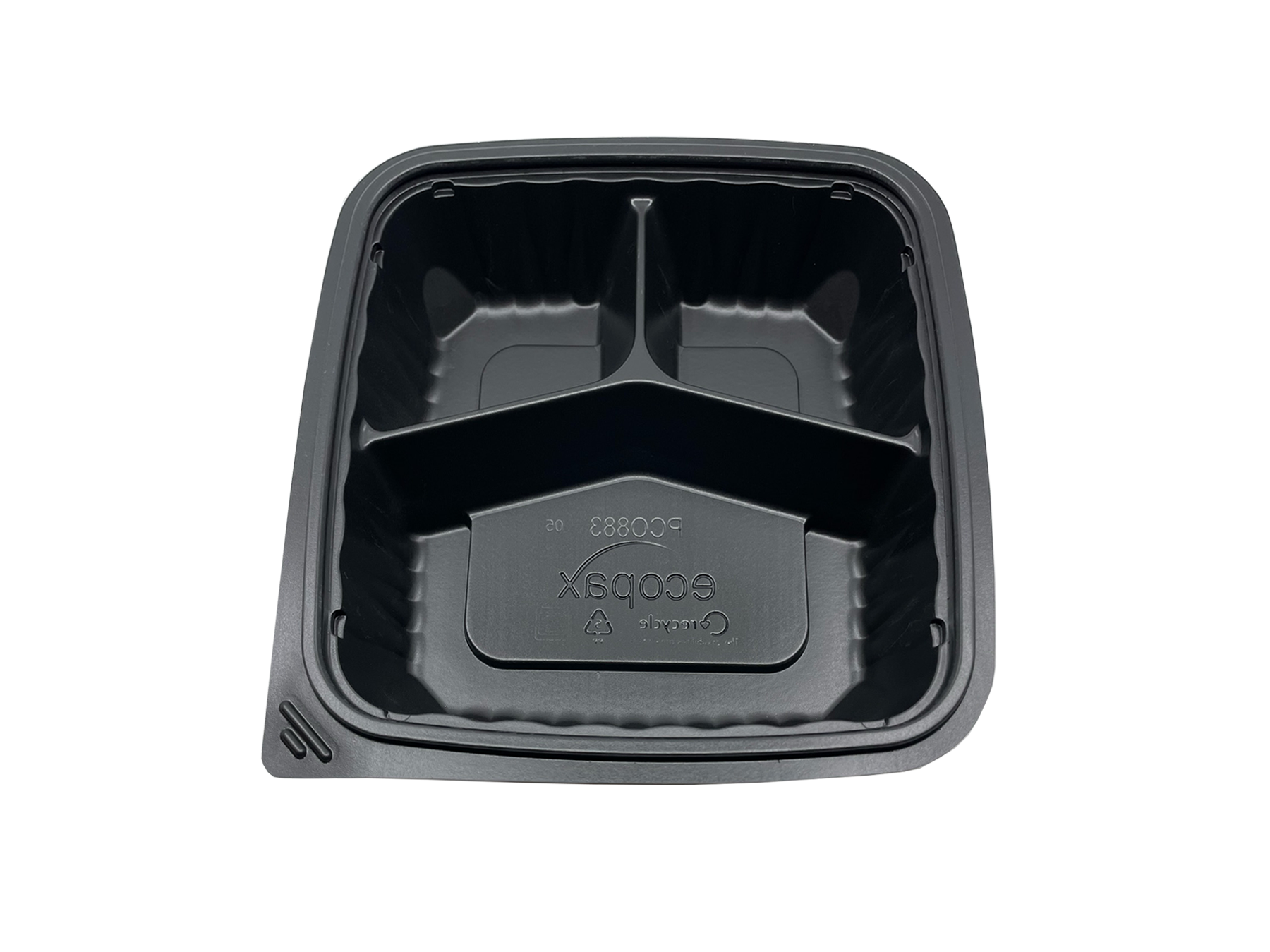





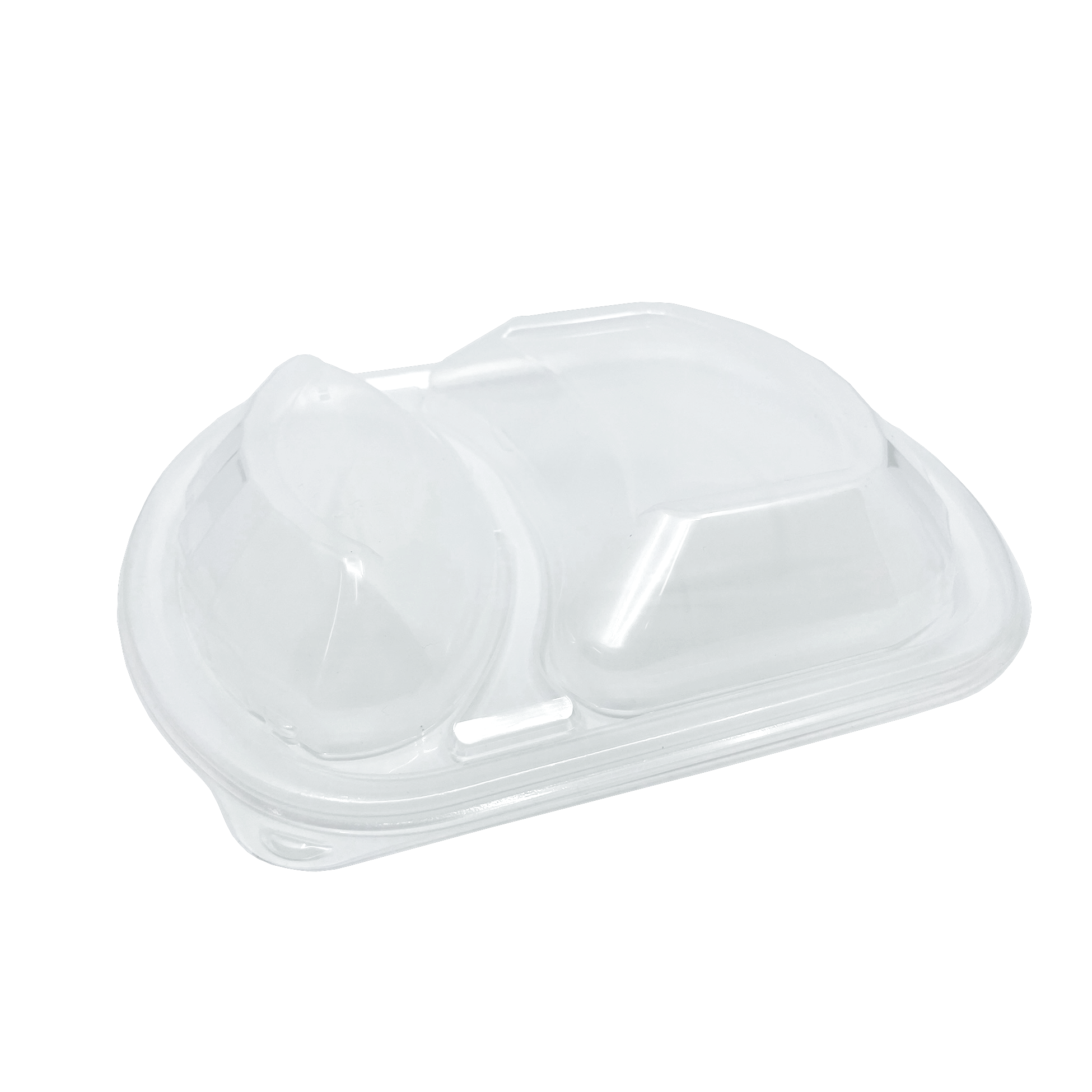




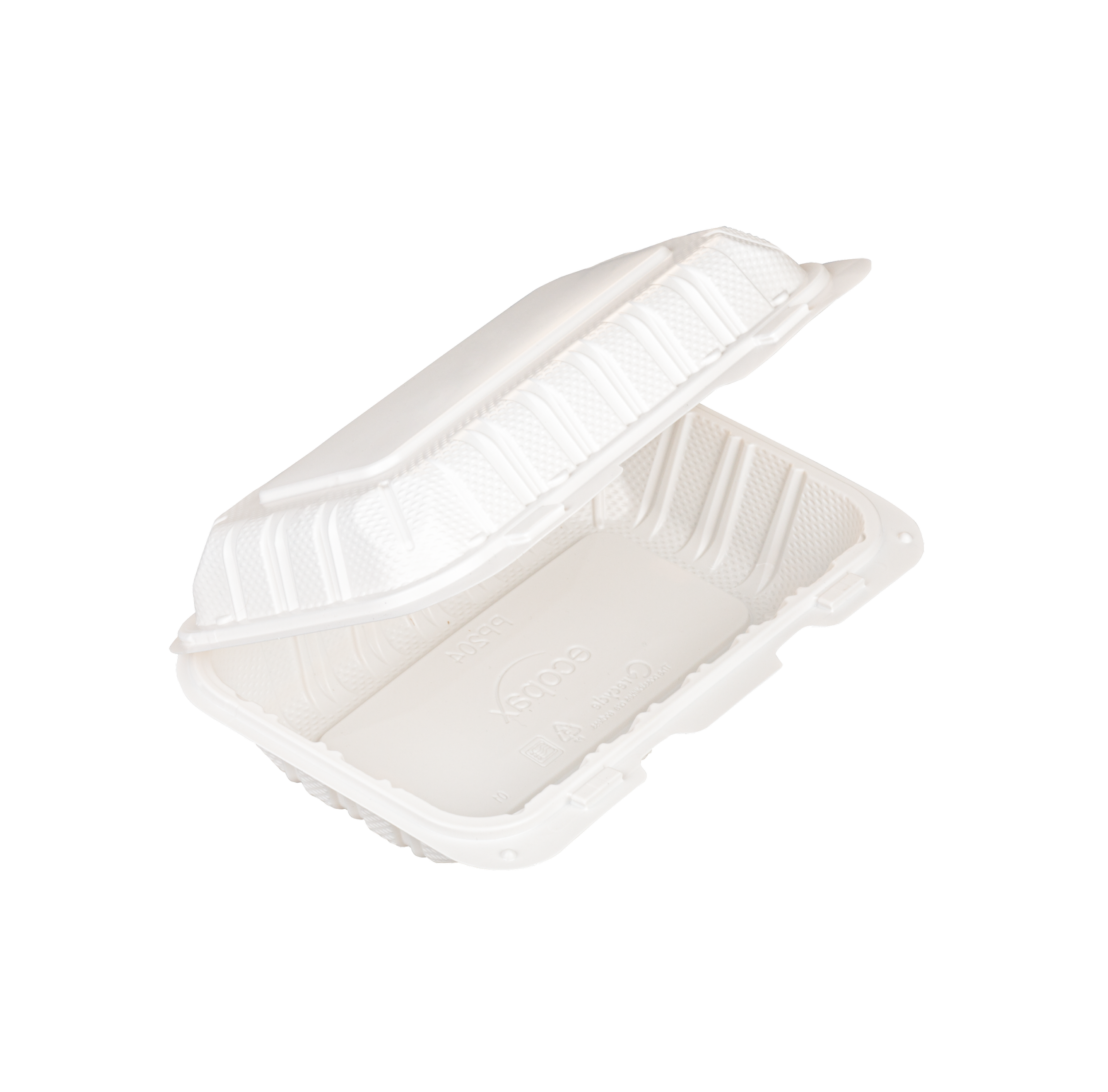

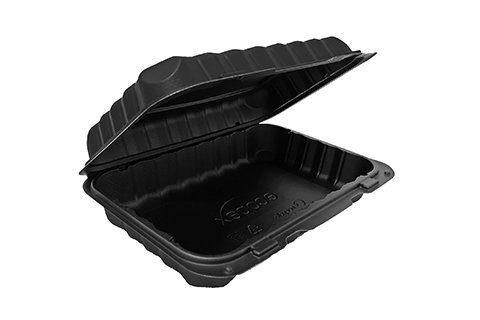
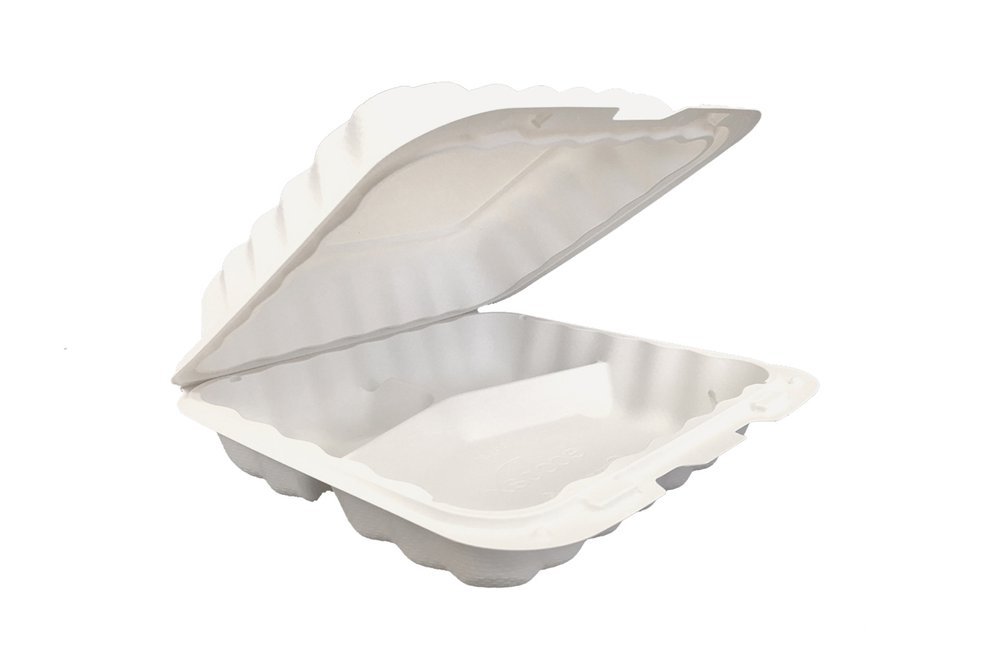



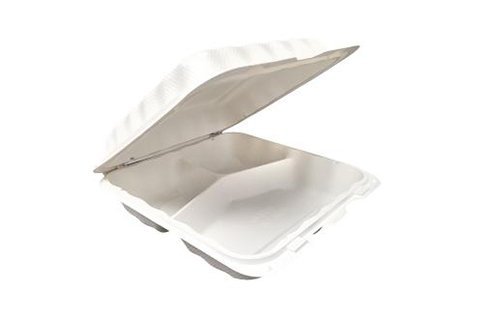











6" x 6" x 3", 1-compartment, black base, clear lid, vented, PP, 320 units combo pack
The Pebble 1-compartment 2- piece container combo pack, measuring 6" x 6" x 3", designed for versatility and convenience in food service. This to-go containers features a durable Mineral-Filled Polypropylene (MFPP) tray and a high quality polypropylene (PP) clear non-vented top, ensuring presentability. This MFPP container is microwave-safe*, making it suitable for both hot and cold foods like burgers, salads, and cheesecakes. Available in 320 units combo pack (320 trays and 320 lids).
*Microwave-safe for reheating only; limit use to under 2 minutes to avoid container degradation or safety risk.